Comprehensive Report: Principles of Health and Social Care
VerifiedAdded on 2019/12/03
|15
|4909
|28
Report
AI Summary
This report provides a comprehensive analysis of the principles of health and social care, encompassing ethical considerations, legislative frameworks, and practical applications within residential care settings. It explores key concepts such as equality, dignity, confidentiality, and privacy in patient care, exemplified through a case study of Bob Small. The report delves into the procedures and evaluation of interpersonal working within health and social care services, highlighting the benefits of a person-centered approach. Furthermore, it addresses ethical dilemmas and conflicts, such as those arising from conflicting patient preferences and medical necessities. The report also examines relevant policies, legislation, regulations, and codes of practice, emphasizing the importance of national and local policy alignment. The discussion includes the positive and negative impacts of these frameworks on healthcare organizations. Finally, the report evaluates the author's roles and responsibilities within the context of health and social care, including recommendations for improving contributions to good practice. The report is a good resource for students on Desklib.
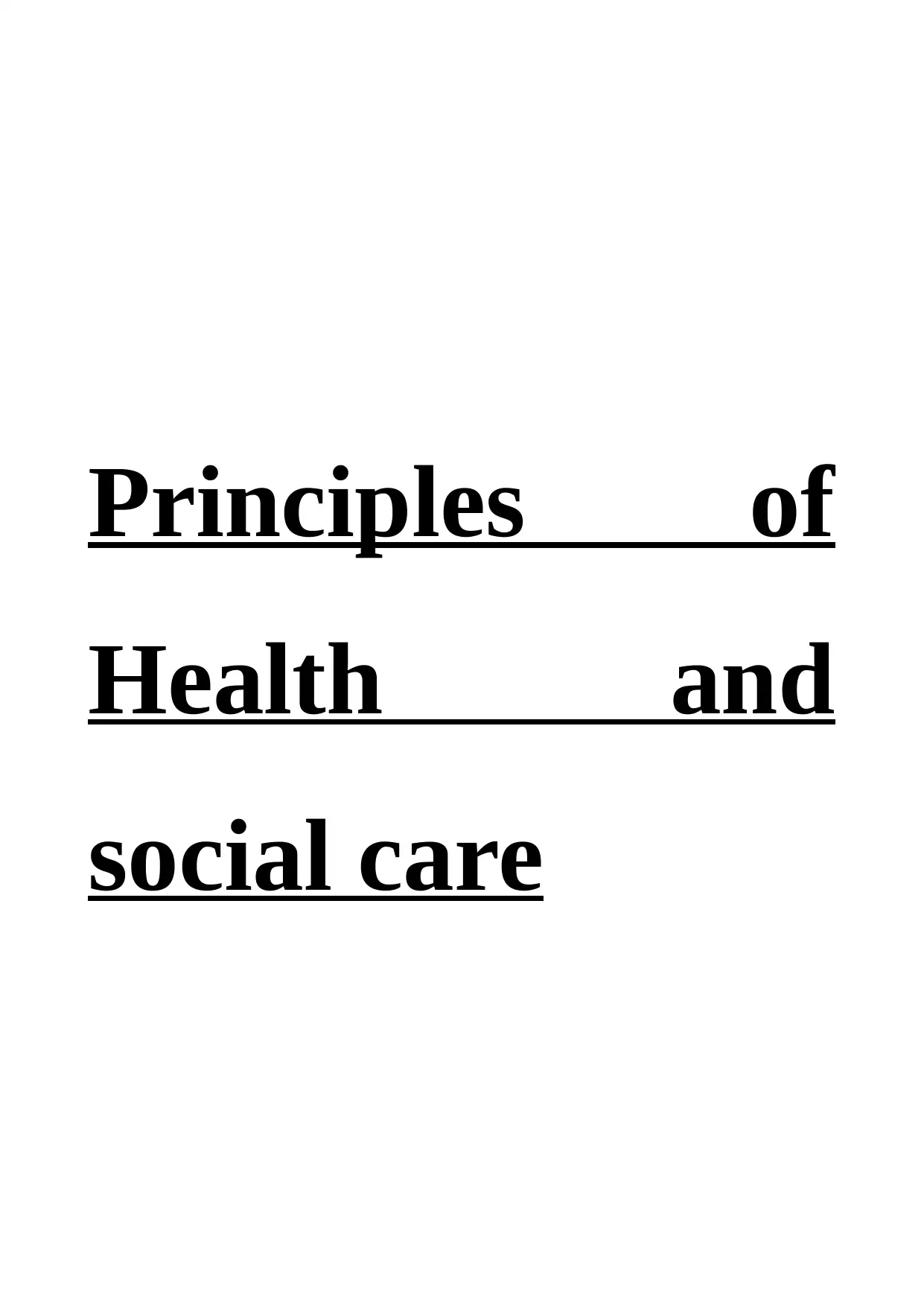
Principles of
Health and
social care
Health and
social care
Paraphrase This Document
Need a fresh take? Get an instant paraphrase of this document with our AI Paraphraser
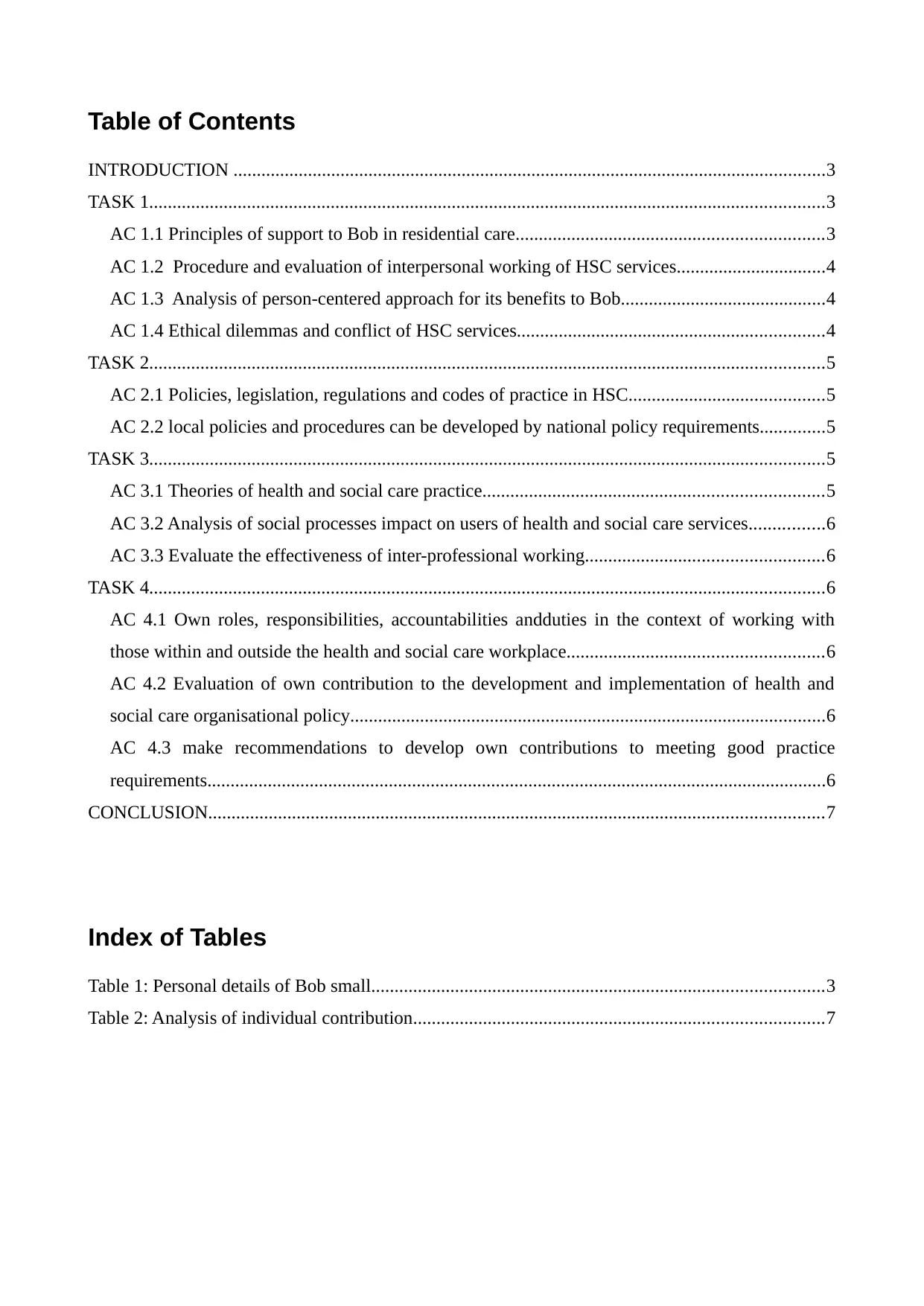
Table of Contents
INTRODUCTION ...............................................................................................................................3
TASK 1.................................................................................................................................................3
AC 1.1 Principles of support to Bob in residential care..................................................................3
AC 1.2 Procedure and evaluation of interpersonal working of HSC services................................4
AC 1.3 Analysis of person-centered approach for its benefits to Bob............................................4
AC 1.4 Ethical dilemmas and conflict of HSC services..................................................................4
TASK 2.................................................................................................................................................5
AC 2.1 Policies, legislation, regulations and codes of practice in HSC..........................................5
AC 2.2 local policies and procedures can be developed by national policy requirements..............5
TASK 3.................................................................................................................................................5
AC 3.1 Theories of health and social care practice.........................................................................5
AC 3.2 Analysis of social processes impact on users of health and social care services................6
AC 3.3 Evaluate the effectiveness of inter-professional working...................................................6
TASK 4.................................................................................................................................................6
AC 4.1 Own roles, responsibilities, accountabilities andduties in the context of working with
those within and outside the health and social care workplace.......................................................6
AC 4.2 Evaluation of own contribution to the development and implementation of health and
social care organisational policy......................................................................................................6
AC 4.3 make recommendations to develop own contributions to meeting good practice
requirements.....................................................................................................................................6
CONCLUSION....................................................................................................................................7
Index of Tables
Table 1: Personal details of Bob small.................................................................................................3
Table 2: Analysis of individual contribution........................................................................................7
INTRODUCTION ...............................................................................................................................3
TASK 1.................................................................................................................................................3
AC 1.1 Principles of support to Bob in residential care..................................................................3
AC 1.2 Procedure and evaluation of interpersonal working of HSC services................................4
AC 1.3 Analysis of person-centered approach for its benefits to Bob............................................4
AC 1.4 Ethical dilemmas and conflict of HSC services..................................................................4
TASK 2.................................................................................................................................................5
AC 2.1 Policies, legislation, regulations and codes of practice in HSC..........................................5
AC 2.2 local policies and procedures can be developed by national policy requirements..............5
TASK 3.................................................................................................................................................5
AC 3.1 Theories of health and social care practice.........................................................................5
AC 3.2 Analysis of social processes impact on users of health and social care services................6
AC 3.3 Evaluate the effectiveness of inter-professional working...................................................6
TASK 4.................................................................................................................................................6
AC 4.1 Own roles, responsibilities, accountabilities andduties in the context of working with
those within and outside the health and social care workplace.......................................................6
AC 4.2 Evaluation of own contribution to the development and implementation of health and
social care organisational policy......................................................................................................6
AC 4.3 make recommendations to develop own contributions to meeting good practice
requirements.....................................................................................................................................6
CONCLUSION....................................................................................................................................7
Index of Tables
Table 1: Personal details of Bob small.................................................................................................3
Table 2: Analysis of individual contribution........................................................................................7
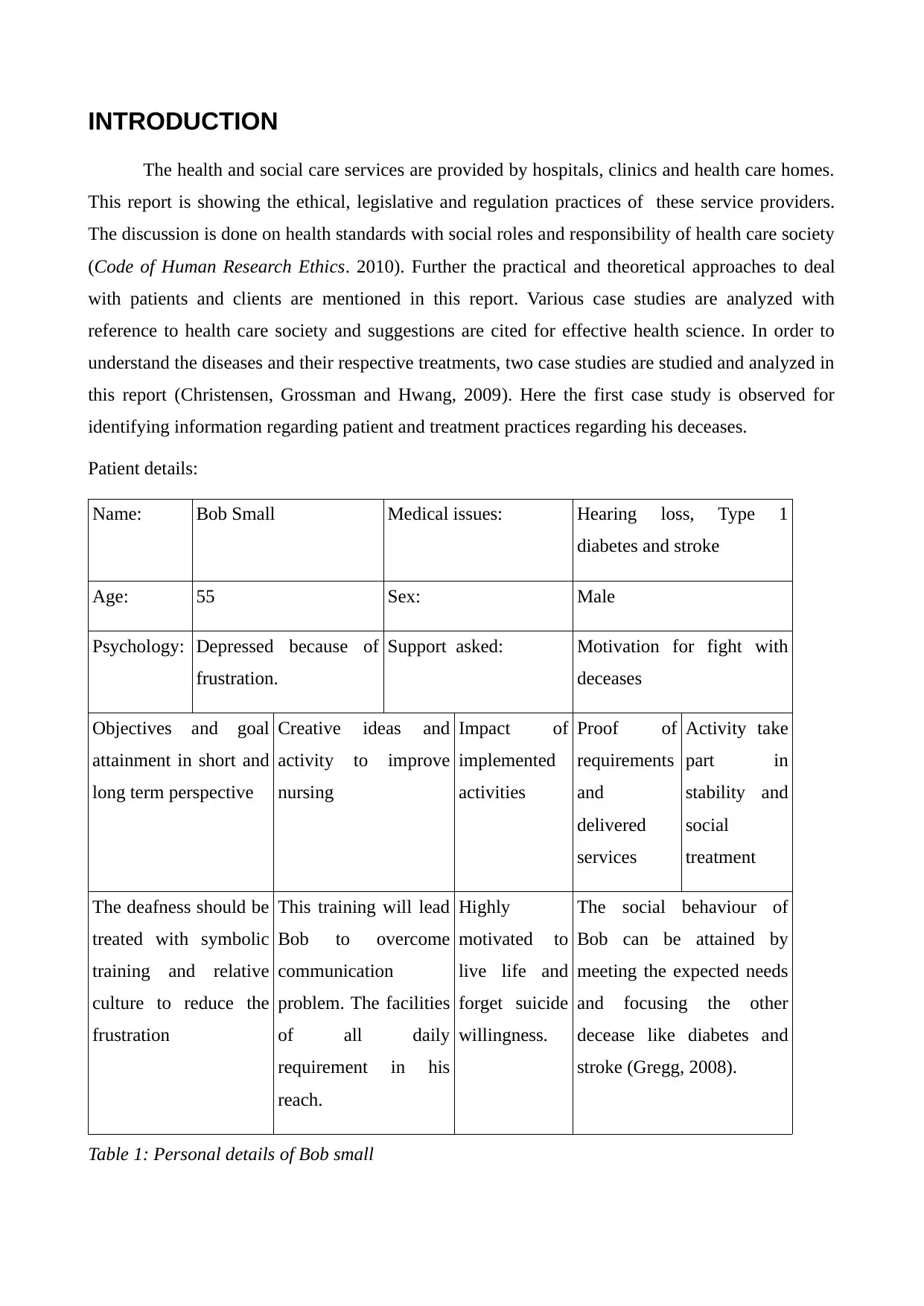
INTRODUCTION
The health and social care services are provided by hospitals, clinics and health care homes.
This report is showing the ethical, legislative and regulation practices of these service providers.
The discussion is done on health standards with social roles and responsibility of health care society
(Code of Human Research Ethics. 2010). Further the practical and theoretical approaches to deal
with patients and clients are mentioned in this report. Various case studies are analyzed with
reference to health care society and suggestions are cited for effective health science. In order to
understand the diseases and their respective treatments, two case studies are studied and analyzed in
this report (Christensen, Grossman and Hwang, 2009). Here the first case study is observed for
identifying information regarding patient and treatment practices regarding his deceases.
Patient details:
Name: Bob Small Medical issues: Hearing loss, Type 1
diabetes and stroke
Age: 55 Sex: Male
Psychology: Depressed because of
frustration.
Support asked: Motivation for fight with
deceases
Objectives and goal
attainment in short and
long term perspective
Creative ideas and
activity to improve
nursing
Impact of
implemented
activities
Proof of
requirements
and
delivered
services
Activity take
part in
stability and
social
treatment
The deafness should be
treated with symbolic
training and relative
culture to reduce the
frustration
This training will lead
Bob to overcome
communication
problem. The facilities
of all daily
requirement in his
reach.
Highly
motivated to
live life and
forget suicide
willingness.
The social behaviour of
Bob can be attained by
meeting the expected needs
and focusing the other
decease like diabetes and
stroke (Gregg, 2008).
Table 1: Personal details of Bob small
The health and social care services are provided by hospitals, clinics and health care homes.
This report is showing the ethical, legislative and regulation practices of these service providers.
The discussion is done on health standards with social roles and responsibility of health care society
(Code of Human Research Ethics. 2010). Further the practical and theoretical approaches to deal
with patients and clients are mentioned in this report. Various case studies are analyzed with
reference to health care society and suggestions are cited for effective health science. In order to
understand the diseases and their respective treatments, two case studies are studied and analyzed in
this report (Christensen, Grossman and Hwang, 2009). Here the first case study is observed for
identifying information regarding patient and treatment practices regarding his deceases.
Patient details:
Name: Bob Small Medical issues: Hearing loss, Type 1
diabetes and stroke
Age: 55 Sex: Male
Psychology: Depressed because of
frustration.
Support asked: Motivation for fight with
deceases
Objectives and goal
attainment in short and
long term perspective
Creative ideas and
activity to improve
nursing
Impact of
implemented
activities
Proof of
requirements
and
delivered
services
Activity take
part in
stability and
social
treatment
The deafness should be
treated with symbolic
training and relative
culture to reduce the
frustration
This training will lead
Bob to overcome
communication
problem. The facilities
of all daily
requirement in his
reach.
Highly
motivated to
live life and
forget suicide
willingness.
The social behaviour of
Bob can be attained by
meeting the expected needs
and focusing the other
decease like diabetes and
stroke (Gregg, 2008).
Table 1: Personal details of Bob small
⊘ This is a preview!⊘
Do you want full access?
Subscribe today to unlock all pages.

Trusted by 1+ million students worldwide
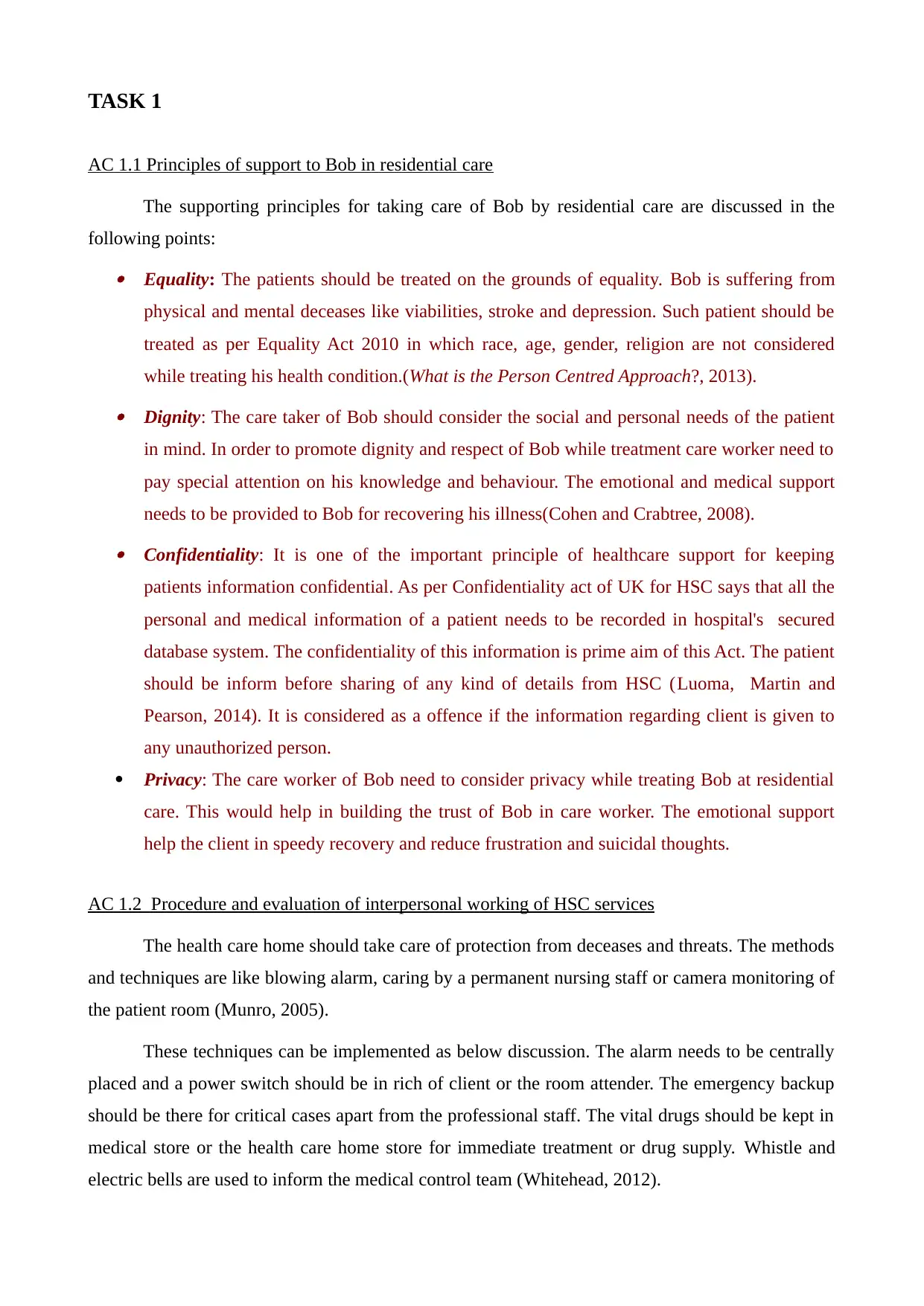
TASK 1
AC 1.1 Principles of support to Bob in residential care
The supporting principles for taking care of Bob by residential care are discussed in the
following points:
Equality: The patients should be treated on the grounds of equality. Bob is suffering from
physical and mental deceases like viabilities, stroke and depression. Such patient should be
treated as per Equality Act 2010 in which race, age, gender, religion are not considered
while treating his health condition.(What is the Person Centred Approach?, 2013).
Dignity: The care taker of Bob should consider the social and personal needs of the patient
in mind. In order to promote dignity and respect of Bob while treatment care worker need to
pay special attention on his knowledge and behaviour. The emotional and medical support
needs to be provided to Bob for recovering his illness(Cohen and Crabtree, 2008).
Confidentiality: It is one of the important principle of healthcare support for keeping
patients information confidential. As per Confidentiality act of UK for HSC says that all the
personal and medical information of a patient needs to be recorded in hospital's secured
database system. The confidentiality of this information is prime aim of this Act. The patient
should be inform before sharing of any kind of details from HSC (Luoma, Martin and
Pearson, 2014). It is considered as a offence if the information regarding client is given to
any unauthorized person.
Privacy: The care worker of Bob need to consider privacy while treating Bob at residential
care. This would help in building the trust of Bob in care worker. The emotional support
help the client in speedy recovery and reduce frustration and suicidal thoughts.
AC 1.2 Procedure and evaluation of interpersonal working of HSC services
The health care home should take care of protection from deceases and threats. The methods
and techniques are like blowing alarm, caring by a permanent nursing staff or camera monitoring of
the patient room (Munro, 2005).
These techniques can be implemented as below discussion. The alarm needs to be centrally
placed and a power switch should be in rich of client or the room attender. The emergency backup
should be there for critical cases apart from the professional staff. The vital drugs should be kept in
medical store or the health care home store for immediate treatment or drug supply. Whistle and
electric bells are used to inform the medical control team (Whitehead, 2012).
AC 1.1 Principles of support to Bob in residential care
The supporting principles for taking care of Bob by residential care are discussed in the
following points:
Equality: The patients should be treated on the grounds of equality. Bob is suffering from
physical and mental deceases like viabilities, stroke and depression. Such patient should be
treated as per Equality Act 2010 in which race, age, gender, religion are not considered
while treating his health condition.(What is the Person Centred Approach?, 2013).
Dignity: The care taker of Bob should consider the social and personal needs of the patient
in mind. In order to promote dignity and respect of Bob while treatment care worker need to
pay special attention on his knowledge and behaviour. The emotional and medical support
needs to be provided to Bob for recovering his illness(Cohen and Crabtree, 2008).
Confidentiality: It is one of the important principle of healthcare support for keeping
patients information confidential. As per Confidentiality act of UK for HSC says that all the
personal and medical information of a patient needs to be recorded in hospital's secured
database system. The confidentiality of this information is prime aim of this Act. The patient
should be inform before sharing of any kind of details from HSC (Luoma, Martin and
Pearson, 2014). It is considered as a offence if the information regarding client is given to
any unauthorized person.
Privacy: The care worker of Bob need to consider privacy while treating Bob at residential
care. This would help in building the trust of Bob in care worker. The emotional support
help the client in speedy recovery and reduce frustration and suicidal thoughts.
AC 1.2 Procedure and evaluation of interpersonal working of HSC services
The health care home should take care of protection from deceases and threats. The methods
and techniques are like blowing alarm, caring by a permanent nursing staff or camera monitoring of
the patient room (Munro, 2005).
These techniques can be implemented as below discussion. The alarm needs to be centrally
placed and a power switch should be in rich of client or the room attender. The emergency backup
should be there for critical cases apart from the professional staff. The vital drugs should be kept in
medical store or the health care home store for immediate treatment or drug supply. Whistle and
electric bells are used to inform the medical control team (Whitehead, 2012).
Paraphrase This Document
Need a fresh take? Get an instant paraphrase of this document with our AI Paraphraser
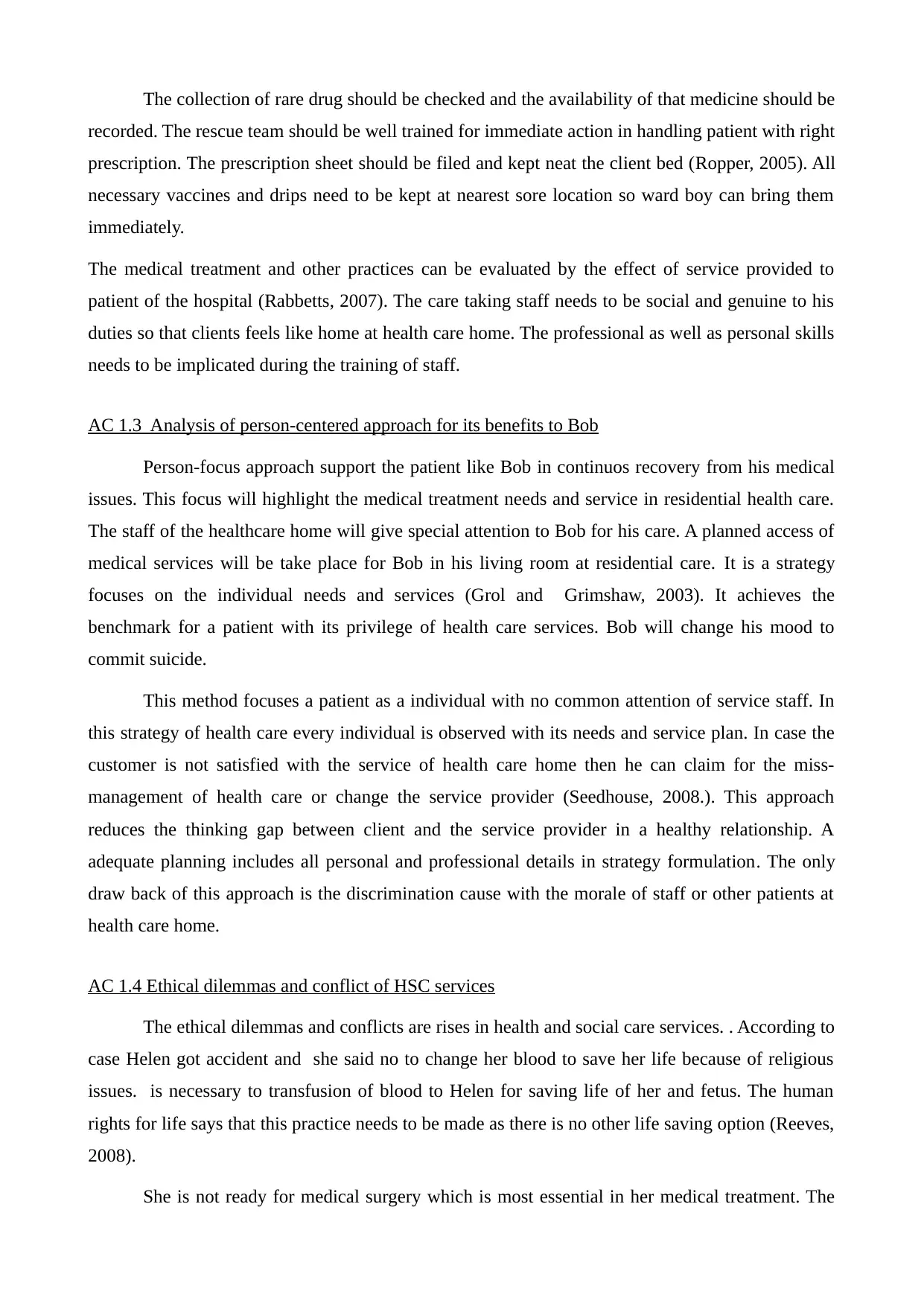
The collection of rare drug should be checked and the availability of that medicine should be
recorded. The rescue team should be well trained for immediate action in handling patient with right
prescription. The prescription sheet should be filed and kept neat the client bed (Ropper, 2005). All
necessary vaccines and drips need to be kept at nearest sore location so ward boy can bring them
immediately.
The medical treatment and other practices can be evaluated by the effect of service provided to
patient of the hospital (Rabbetts, 2007). The care taking staff needs to be social and genuine to his
duties so that clients feels like home at health care home. The professional as well as personal skills
needs to be implicated during the training of staff.
AC 1.3 Analysis of person-centered approach for its benefits to Bob
Person-focus approach support the patient like Bob in continuos recovery from his medical
issues. This focus will highlight the medical treatment needs and service in residential health care.
The staff of the healthcare home will give special attention to Bob for his care. A planned access of
medical services will be take place for Bob in his living room at residential care. It is a strategy
focuses on the individual needs and services (Grol and Grimshaw, 2003). It achieves the
benchmark for a patient with its privilege of health care services. Bob will change his mood to
commit suicide.
This method focuses a patient as a individual with no common attention of service staff. In
this strategy of health care every individual is observed with its needs and service plan. In case the
customer is not satisfied with the service of health care home then he can claim for the miss-
management of health care or change the service provider (Seedhouse, 2008.). This approach
reduces the thinking gap between client and the service provider in a healthy relationship. A
adequate planning includes all personal and professional details in strategy formulation. The only
draw back of this approach is the discrimination cause with the morale of staff or other patients at
health care home.
AC 1.4 Ethical dilemmas and conflict of HSC services
The ethical dilemmas and conflicts are rises in health and social care services. . According to
case Helen got accident and she said no to change her blood to save her life because of religious
issues. is necessary to transfusion of blood to Helen for saving life of her and fetus. The human
rights for life says that this practice needs to be made as there is no other life saving option (Reeves,
2008).
She is not ready for medical surgery which is most essential in her medical treatment. The
recorded. The rescue team should be well trained for immediate action in handling patient with right
prescription. The prescription sheet should be filed and kept neat the client bed (Ropper, 2005). All
necessary vaccines and drips need to be kept at nearest sore location so ward boy can bring them
immediately.
The medical treatment and other practices can be evaluated by the effect of service provided to
patient of the hospital (Rabbetts, 2007). The care taking staff needs to be social and genuine to his
duties so that clients feels like home at health care home. The professional as well as personal skills
needs to be implicated during the training of staff.
AC 1.3 Analysis of person-centered approach for its benefits to Bob
Person-focus approach support the patient like Bob in continuos recovery from his medical
issues. This focus will highlight the medical treatment needs and service in residential health care.
The staff of the healthcare home will give special attention to Bob for his care. A planned access of
medical services will be take place for Bob in his living room at residential care. It is a strategy
focuses on the individual needs and services (Grol and Grimshaw, 2003). It achieves the
benchmark for a patient with its privilege of health care services. Bob will change his mood to
commit suicide.
This method focuses a patient as a individual with no common attention of service staff. In
this strategy of health care every individual is observed with its needs and service plan. In case the
customer is not satisfied with the service of health care home then he can claim for the miss-
management of health care or change the service provider (Seedhouse, 2008.). This approach
reduces the thinking gap between client and the service provider in a healthy relationship. A
adequate planning includes all personal and professional details in strategy formulation. The only
draw back of this approach is the discrimination cause with the morale of staff or other patients at
health care home.
AC 1.4 Ethical dilemmas and conflict of HSC services
The ethical dilemmas and conflicts are rises in health and social care services. . According to
case Helen got accident and she said no to change her blood to save her life because of religious
issues. is necessary to transfusion of blood to Helen for saving life of her and fetus. The human
rights for life says that this practice needs to be made as there is no other life saving option (Reeves,
2008).
She is not ready for medical surgery which is most essential in her medical treatment. The
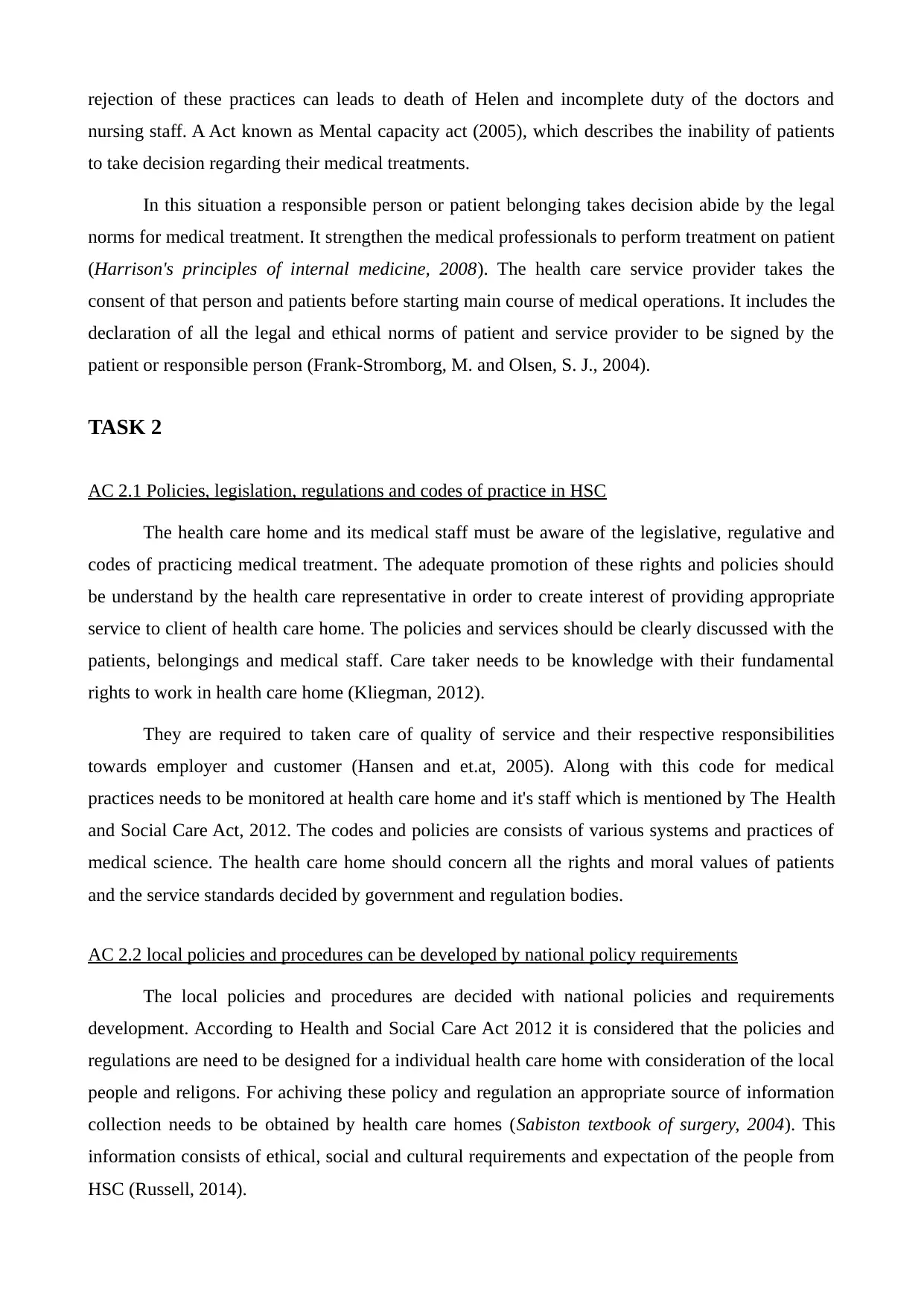
rejection of these practices can leads to death of Helen and incomplete duty of the doctors and
nursing staff. A Act known as Mental capacity act (2005), which describes the inability of patients
to take decision regarding their medical treatments.
In this situation a responsible person or patient belonging takes decision abide by the legal
norms for medical treatment. It strengthen the medical professionals to perform treatment on patient
(Harrison's principles of internal medicine, 2008). The health care service provider takes the
consent of that person and patients before starting main course of medical operations. It includes the
declaration of all the legal and ethical norms of patient and service provider to be signed by the
patient or responsible person (Frank-Stromborg, M. and Olsen, S. J., 2004).
TASK 2
AC 2.1 Policies, legislation, regulations and codes of practice in HSC
The health care home and its medical staff must be aware of the legislative, regulative and
codes of practicing medical treatment. The adequate promotion of these rights and policies should
be understand by the health care representative in order to create interest of providing appropriate
service to client of health care home. The policies and services should be clearly discussed with the
patients, belongings and medical staff. Care taker needs to be knowledge with their fundamental
rights to work in health care home (Kliegman, 2012).
They are required to taken care of quality of service and their respective responsibilities
towards employer and customer (Hansen and et.at, 2005). Along with this code for medical
practices needs to be monitored at health care home and it's staff which is mentioned by The Health
and Social Care Act, 2012. The codes and policies are consists of various systems and practices of
medical science. The health care home should concern all the rights and moral values of patients
and the service standards decided by government and regulation bodies.
AC 2.2 local policies and procedures can be developed by national policy requirements
The local policies and procedures are decided with national policies and requirements
development. According to Health and Social Care Act 2012 it is considered that the policies and
regulations are need to be designed for a individual health care home with consideration of the local
people and religons. For achiving these policy and regulation an appropriate source of information
collection needs to be obtained by health care homes (Sabiston textbook of surgery, 2004). This
information consists of ethical, social and cultural requirements and expectation of the people from
HSC (Russell, 2014).
nursing staff. A Act known as Mental capacity act (2005), which describes the inability of patients
to take decision regarding their medical treatments.
In this situation a responsible person or patient belonging takes decision abide by the legal
norms for medical treatment. It strengthen the medical professionals to perform treatment on patient
(Harrison's principles of internal medicine, 2008). The health care service provider takes the
consent of that person and patients before starting main course of medical operations. It includes the
declaration of all the legal and ethical norms of patient and service provider to be signed by the
patient or responsible person (Frank-Stromborg, M. and Olsen, S. J., 2004).
TASK 2
AC 2.1 Policies, legislation, regulations and codes of practice in HSC
The health care home and its medical staff must be aware of the legislative, regulative and
codes of practicing medical treatment. The adequate promotion of these rights and policies should
be understand by the health care representative in order to create interest of providing appropriate
service to client of health care home. The policies and services should be clearly discussed with the
patients, belongings and medical staff. Care taker needs to be knowledge with their fundamental
rights to work in health care home (Kliegman, 2012).
They are required to taken care of quality of service and their respective responsibilities
towards employer and customer (Hansen and et.at, 2005). Along with this code for medical
practices needs to be monitored at health care home and it's staff which is mentioned by The Health
and Social Care Act, 2012. The codes and policies are consists of various systems and practices of
medical science. The health care home should concern all the rights and moral values of patients
and the service standards decided by government and regulation bodies.
AC 2.2 local policies and procedures can be developed by national policy requirements
The local policies and procedures are decided with national policies and requirements
development. According to Health and Social Care Act 2012 it is considered that the policies and
regulations are need to be designed for a individual health care home with consideration of the local
people and religons. For achiving these policy and regulation an appropriate source of information
collection needs to be obtained by health care homes (Sabiston textbook of surgery, 2004). This
information consists of ethical, social and cultural requirements and expectation of the people from
HSC (Russell, 2014).
⊘ This is a preview!⊘
Do you want full access?
Subscribe today to unlock all pages.

Trusted by 1+ million students worldwide
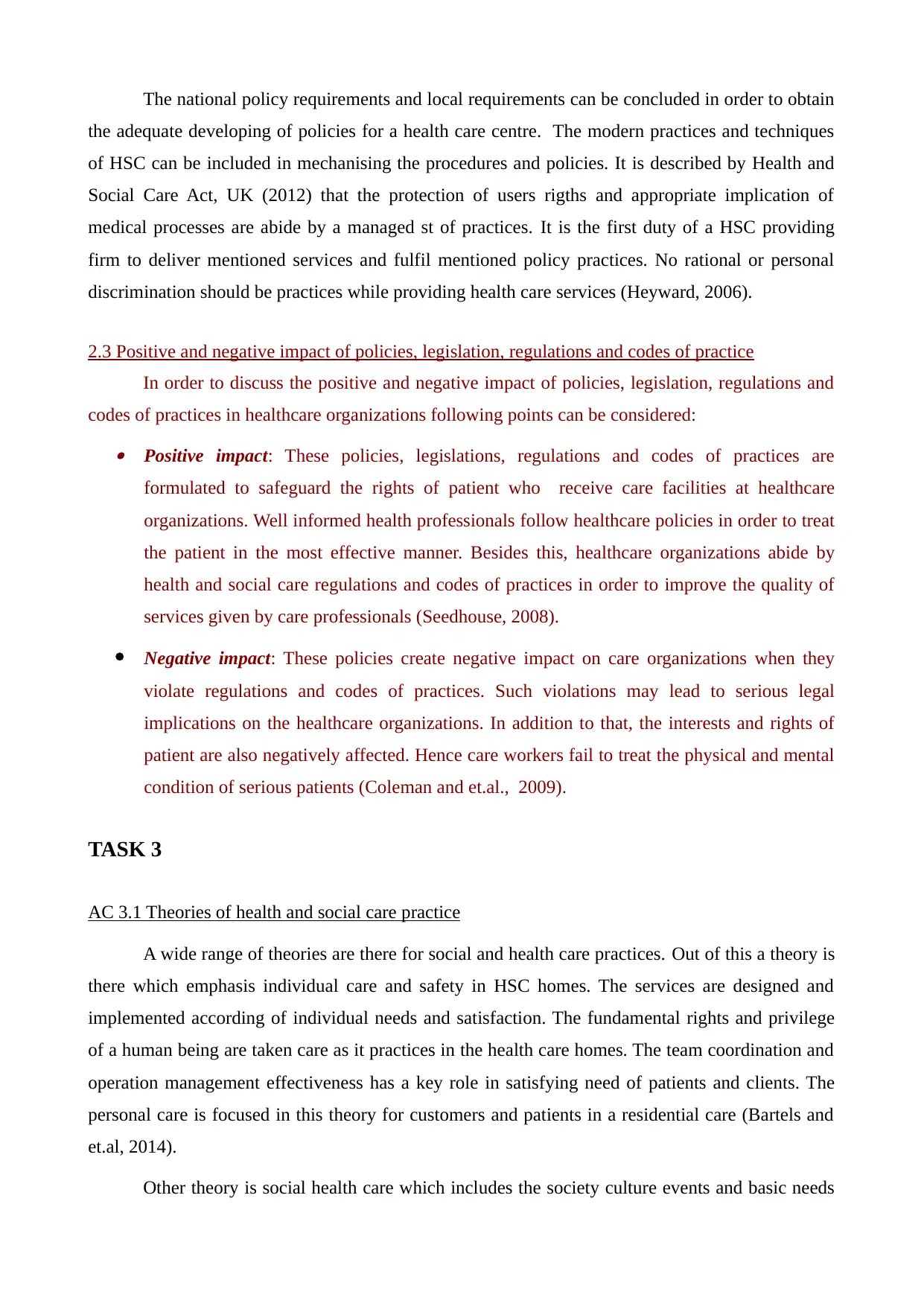
The national policy requirements and local requirements can be concluded in order to obtain
the adequate developing of policies for a health care centre. The modern practices and techniques
of HSC can be included in mechanising the procedures and policies. It is described by Health and
Social Care Act, UK (2012) that the protection of users rigths and appropriate implication of
medical processes are abide by a managed st of practices. It is the first duty of a HSC providing
firm to deliver mentioned services and fulfil mentioned policy practices. No rational or personal
discrimination should be practices while providing health care services (Heyward, 2006).
2.3 Positive and negative impact of policies, legislation, regulations and codes of practice
In order to discuss the positive and negative impact of policies, legislation, regulations and
codes of practices in healthcare organizations following points can be considered:
Positive impact: These policies, legislations, regulations and codes of practices are
formulated to safeguard the rights of patient who receive care facilities at healthcare
organizations. Well informed health professionals follow healthcare policies in order to treat
the patient in the most effective manner. Besides this, healthcare organizations abide by
health and social care regulations and codes of practices in order to improve the quality of
services given by care professionals (Seedhouse, 2008).
Negative impact: These policies create negative impact on care organizations when they
violate regulations and codes of practices. Such violations may lead to serious legal
implications on the healthcare organizations. In addition to that, the interests and rights of
patient are also negatively affected. Hence care workers fail to treat the physical and mental
condition of serious patients (Coleman and et.al., 2009).
TASK 3
AC 3.1 Theories of health and social care practice
A wide range of theories are there for social and health care practices. Out of this a theory is
there which emphasis individual care and safety in HSC homes. The services are designed and
implemented according of individual needs and satisfaction. The fundamental rights and privilege
of a human being are taken care as it practices in the health care homes. The team coordination and
operation management effectiveness has a key role in satisfying need of patients and clients. The
personal care is focused in this theory for customers and patients in a residential care (Bartels and
et.al, 2014).
Other theory is social health care which includes the society culture events and basic needs
the adequate developing of policies for a health care centre. The modern practices and techniques
of HSC can be included in mechanising the procedures and policies. It is described by Health and
Social Care Act, UK (2012) that the protection of users rigths and appropriate implication of
medical processes are abide by a managed st of practices. It is the first duty of a HSC providing
firm to deliver mentioned services and fulfil mentioned policy practices. No rational or personal
discrimination should be practices while providing health care services (Heyward, 2006).
2.3 Positive and negative impact of policies, legislation, regulations and codes of practice
In order to discuss the positive and negative impact of policies, legislation, regulations and
codes of practices in healthcare organizations following points can be considered:
Positive impact: These policies, legislations, regulations and codes of practices are
formulated to safeguard the rights of patient who receive care facilities at healthcare
organizations. Well informed health professionals follow healthcare policies in order to treat
the patient in the most effective manner. Besides this, healthcare organizations abide by
health and social care regulations and codes of practices in order to improve the quality of
services given by care professionals (Seedhouse, 2008).
Negative impact: These policies create negative impact on care organizations when they
violate regulations and codes of practices. Such violations may lead to serious legal
implications on the healthcare organizations. In addition to that, the interests and rights of
patient are also negatively affected. Hence care workers fail to treat the physical and mental
condition of serious patients (Coleman and et.al., 2009).
TASK 3
AC 3.1 Theories of health and social care practice
A wide range of theories are there for social and health care practices. Out of this a theory is
there which emphasis individual care and safety in HSC homes. The services are designed and
implemented according of individual needs and satisfaction. The fundamental rights and privilege
of a human being are taken care as it practices in the health care homes. The team coordination and
operation management effectiveness has a key role in satisfying need of patients and clients. The
personal care is focused in this theory for customers and patients in a residential care (Bartels and
et.al, 2014).
Other theory is social health care which includes the society culture events and basic needs
Paraphrase This Document
Need a fresh take? Get an instant paraphrase of this document with our AI Paraphraser
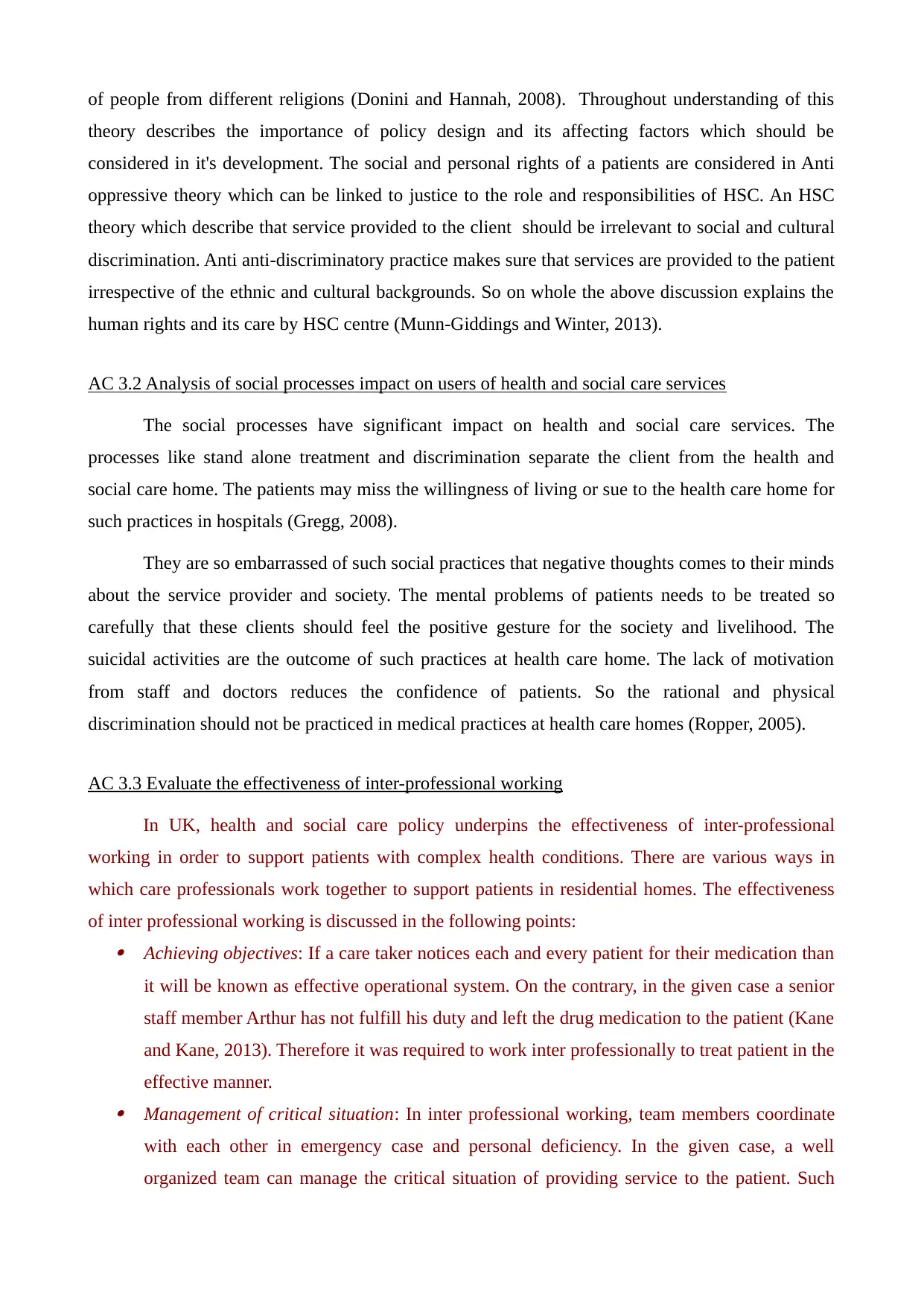
of people from different religions (Donini and Hannah, 2008). Throughout understanding of this
theory describes the importance of policy design and its affecting factors which should be
considered in it's development. The social and personal rights of a patients are considered in Anti
oppressive theory which can be linked to justice to the role and responsibilities of HSC. An HSC
theory which describe that service provided to the client should be irrelevant to social and cultural
discrimination. Anti anti-discriminatory practice makes sure that services are provided to the patient
irrespective of the ethnic and cultural backgrounds. So on whole the above discussion explains the
human rights and its care by HSC centre (Munn-Giddings and Winter, 2013).
AC 3.2 Analysis of social processes impact on users of health and social care services
The social processes have significant impact on health and social care services. The
processes like stand alone treatment and discrimination separate the client from the health and
social care home. The patients may miss the willingness of living or sue to the health care home for
such practices in hospitals (Gregg, 2008).
They are so embarrassed of such social practices that negative thoughts comes to their minds
about the service provider and society. The mental problems of patients needs to be treated so
carefully that these clients should feel the positive gesture for the society and livelihood. The
suicidal activities are the outcome of such practices at health care home. The lack of motivation
from staff and doctors reduces the confidence of patients. So the rational and physical
discrimination should not be practiced in medical practices at health care homes (Ropper, 2005).
AC 3.3 Evaluate the effectiveness of inter-professional working
In UK, health and social care policy underpins the effectiveness of inter-professional
working in order to support patients with complex health conditions. There are various ways in
which care professionals work together to support patients in residential homes. The effectiveness
of inter professional working is discussed in the following points: Achieving objectives: If a care taker notices each and every patient for their medication than
it will be known as effective operational system. On the contrary, in the given case a senior
staff member Arthur has not fulfill his duty and left the drug medication to the patient (Kane
and Kane, 2013). Therefore it was required to work inter professionally to treat patient in the
effective manner. Management of critical situation: In inter professional working, team members coordinate
with each other in emergency case and personal deficiency. In the given case, a well
organized team can manage the critical situation of providing service to the patient. Such
theory describes the importance of policy design and its affecting factors which should be
considered in it's development. The social and personal rights of a patients are considered in Anti
oppressive theory which can be linked to justice to the role and responsibilities of HSC. An HSC
theory which describe that service provided to the client should be irrelevant to social and cultural
discrimination. Anti anti-discriminatory practice makes sure that services are provided to the patient
irrespective of the ethnic and cultural backgrounds. So on whole the above discussion explains the
human rights and its care by HSC centre (Munn-Giddings and Winter, 2013).
AC 3.2 Analysis of social processes impact on users of health and social care services
The social processes have significant impact on health and social care services. The
processes like stand alone treatment and discrimination separate the client from the health and
social care home. The patients may miss the willingness of living or sue to the health care home for
such practices in hospitals (Gregg, 2008).
They are so embarrassed of such social practices that negative thoughts comes to their minds
about the service provider and society. The mental problems of patients needs to be treated so
carefully that these clients should feel the positive gesture for the society and livelihood. The
suicidal activities are the outcome of such practices at health care home. The lack of motivation
from staff and doctors reduces the confidence of patients. So the rational and physical
discrimination should not be practiced in medical practices at health care homes (Ropper, 2005).
AC 3.3 Evaluate the effectiveness of inter-professional working
In UK, health and social care policy underpins the effectiveness of inter-professional
working in order to support patients with complex health conditions. There are various ways in
which care professionals work together to support patients in residential homes. The effectiveness
of inter professional working is discussed in the following points: Achieving objectives: If a care taker notices each and every patient for their medication than
it will be known as effective operational system. On the contrary, in the given case a senior
staff member Arthur has not fulfill his duty and left the drug medication to the patient (Kane
and Kane, 2013). Therefore it was required to work inter professionally to treat patient in the
effective manner. Management of critical situation: In inter professional working, team members coordinate
with each other in emergency case and personal deficiency. In the given case, a well
organized team can manage the critical situation of providing service to the patient. Such
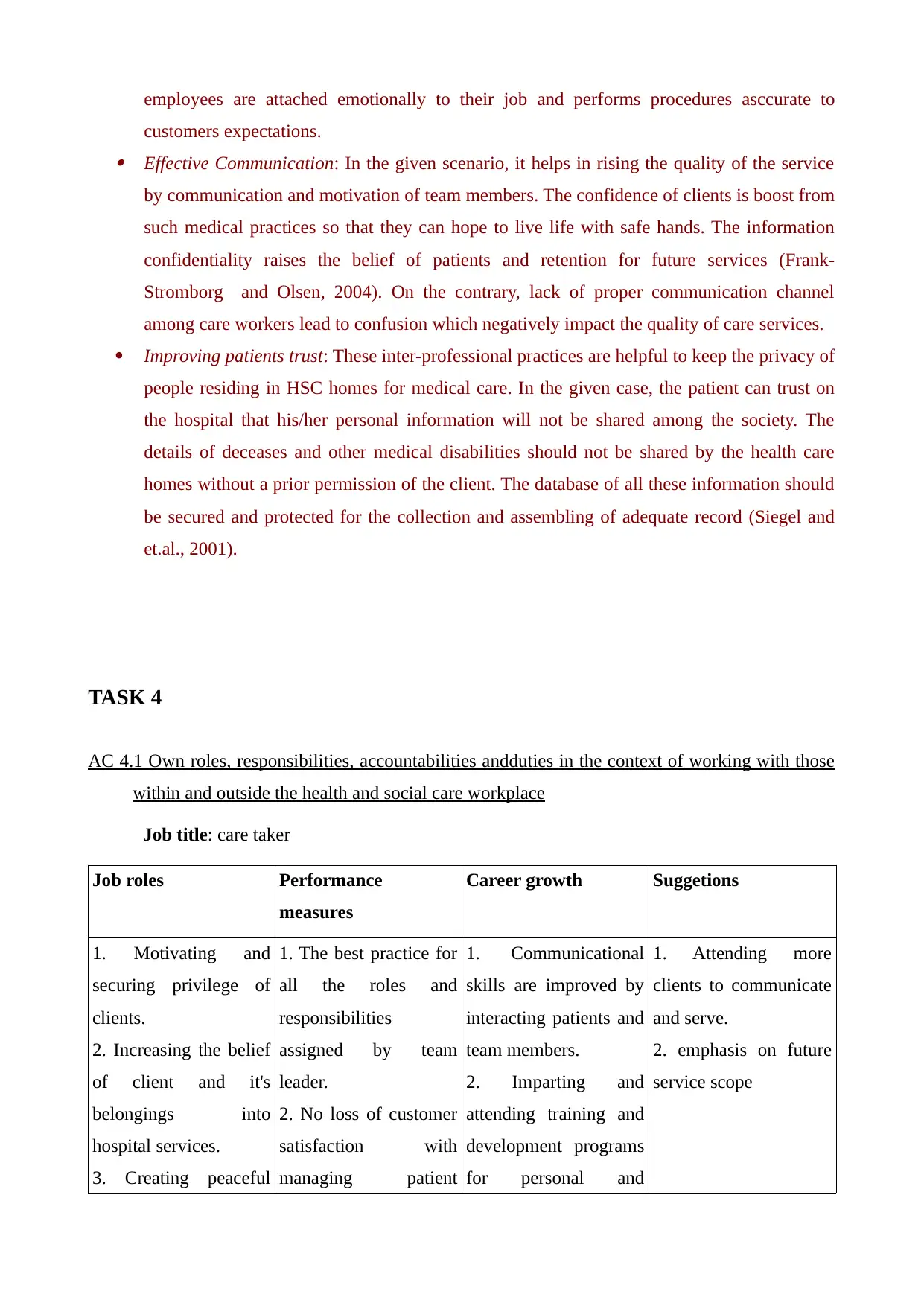
employees are attached emotionally to their job and performs procedures asccurate to
customers expectations. Effective Communication: In the given scenario, it helps in rising the quality of the service
by communication and motivation of team members. The confidence of clients is boost from
such medical practices so that they can hope to live life with safe hands. The information
confidentiality raises the belief of patients and retention for future services (Frank-
Stromborg and Olsen, 2004). On the contrary, lack of proper communication channel
among care workers lead to confusion which negatively impact the quality of care services.
Improving patients trust: These inter-professional practices are helpful to keep the privacy of
people residing in HSC homes for medical care. In the given case, the patient can trust on
the hospital that his/her personal information will not be shared among the society. The
details of deceases and other medical disabilities should not be shared by the health care
homes without a prior permission of the client. The database of all these information should
be secured and protected for the collection and assembling of adequate record (Siegel and
et.al., 2001).
TASK 4
AC 4.1 Own roles, responsibilities, accountabilities andduties in the context of working with those
within and outside the health and social care workplace
Job title: care taker
Job roles Performance
measures
Career growth Suggetions
1. Motivating and
securing privilege of
clients.
2. Increasing the belief
of client and it's
belongings into
hospital services.
3. Creating peaceful
1. The best practice for
all the roles and
responsibilities
assigned by team
leader.
2. No loss of customer
satisfaction with
managing patient
1. Communicational
skills are improved by
interacting patients and
team members.
2. Imparting and
attending training and
development programs
for personal and
1. Attending more
clients to communicate
and serve.
2. emphasis on future
service scope
customers expectations. Effective Communication: In the given scenario, it helps in rising the quality of the service
by communication and motivation of team members. The confidence of clients is boost from
such medical practices so that they can hope to live life with safe hands. The information
confidentiality raises the belief of patients and retention for future services (Frank-
Stromborg and Olsen, 2004). On the contrary, lack of proper communication channel
among care workers lead to confusion which negatively impact the quality of care services.
Improving patients trust: These inter-professional practices are helpful to keep the privacy of
people residing in HSC homes for medical care. In the given case, the patient can trust on
the hospital that his/her personal information will not be shared among the society. The
details of deceases and other medical disabilities should not be shared by the health care
homes without a prior permission of the client. The database of all these information should
be secured and protected for the collection and assembling of adequate record (Siegel and
et.al., 2001).
TASK 4
AC 4.1 Own roles, responsibilities, accountabilities andduties in the context of working with those
within and outside the health and social care workplace
Job title: care taker
Job roles Performance
measures
Career growth Suggetions
1. Motivating and
securing privilege of
clients.
2. Increasing the belief
of client and it's
belongings into
hospital services.
3. Creating peaceful
1. The best practice for
all the roles and
responsibilities
assigned by team
leader.
2. No loss of customer
satisfaction with
managing patient
1. Communicational
skills are improved by
interacting patients and
team members.
2. Imparting and
attending training and
development programs
for personal and
1. Attending more
clients to communicate
and serve.
2. emphasis on future
service scope
⊘ This is a preview!⊘
Do you want full access?
Subscribe today to unlock all pages.

Trusted by 1+ million students worldwide
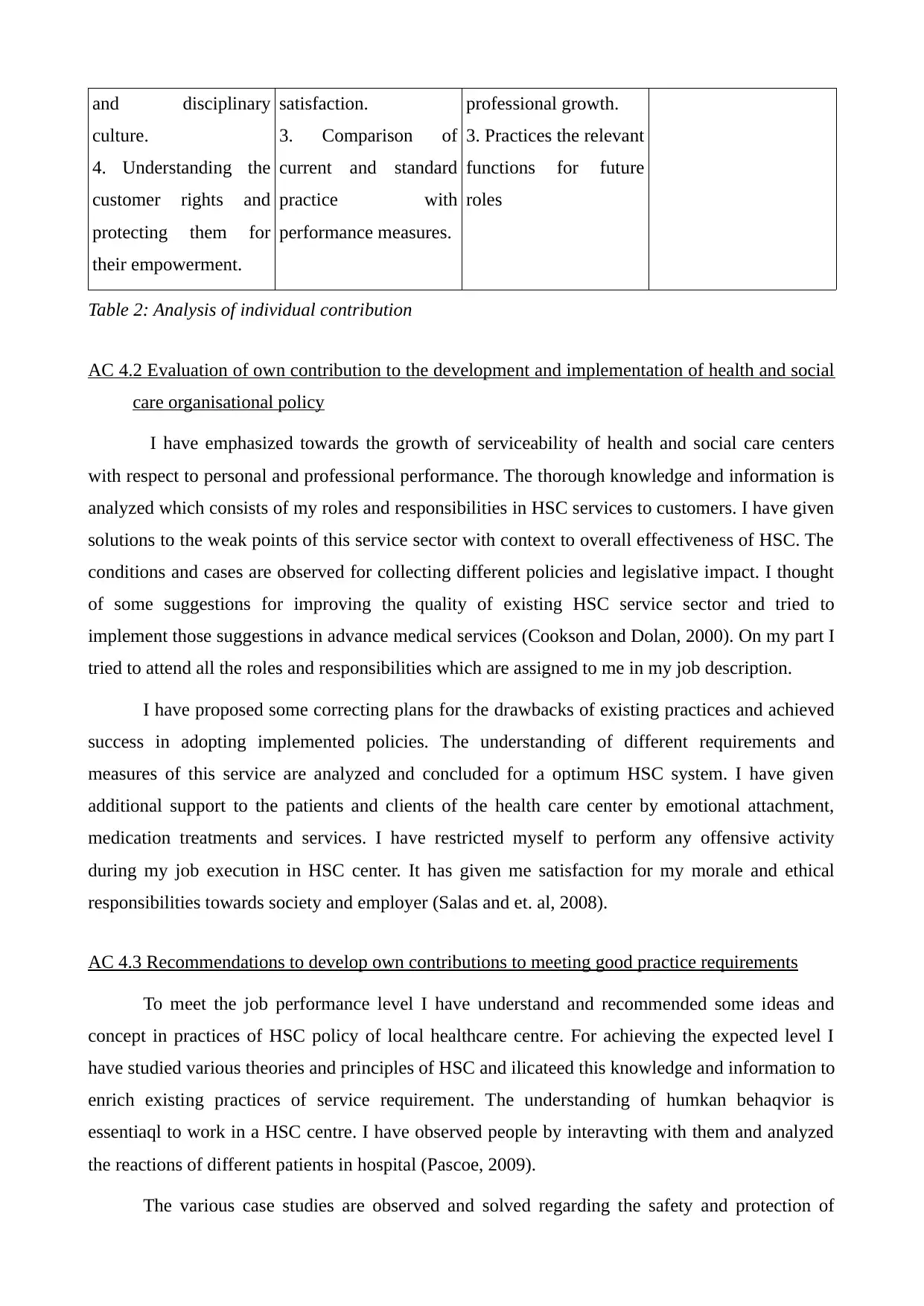
and disciplinary
culture.
4. Understanding the
customer rights and
protecting them for
their empowerment.
satisfaction.
3. Comparison of
current and standard
practice with
performance measures.
professional growth.
3. Practices the relevant
functions for future
roles
Table 2: Analysis of individual contribution
AC 4.2 Evaluation of own contribution to the development and implementation of health and social
care organisational policy
I have emphasized towards the growth of serviceability of health and social care centers
with respect to personal and professional performance. The thorough knowledge and information is
analyzed which consists of my roles and responsibilities in HSC services to customers. I have given
solutions to the weak points of this service sector with context to overall effectiveness of HSC. The
conditions and cases are observed for collecting different policies and legislative impact. I thought
of some suggestions for improving the quality of existing HSC service sector and tried to
implement those suggestions in advance medical services (Cookson and Dolan, 2000). On my part I
tried to attend all the roles and responsibilities which are assigned to me in my job description.
I have proposed some correcting plans for the drawbacks of existing practices and achieved
success in adopting implemented policies. The understanding of different requirements and
measures of this service are analyzed and concluded for a optimum HSC system. I have given
additional support to the patients and clients of the health care center by emotional attachment,
medication treatments and services. I have restricted myself to perform any offensive activity
during my job execution in HSC center. It has given me satisfaction for my morale and ethical
responsibilities towards society and employer (Salas and et. al, 2008).
AC 4.3 Recommendations to develop own contributions to meeting good practice requirements
To meet the job performance level I have understand and recommended some ideas and
concept in practices of HSC policy of local healthcare centre. For achieving the expected level I
have studied various theories and principles of HSC and ilicateed this knowledge and information to
enrich existing practices of service requirement. The understanding of humkan behaqvior is
essentiaql to work in a HSC centre. I have observed people by interavting with them and analyzed
the reactions of different patients in hospital (Pascoe, 2009).
The various case studies are observed and solved regarding the safety and protection of
culture.
4. Understanding the
customer rights and
protecting them for
their empowerment.
satisfaction.
3. Comparison of
current and standard
practice with
performance measures.
professional growth.
3. Practices the relevant
functions for future
roles
Table 2: Analysis of individual contribution
AC 4.2 Evaluation of own contribution to the development and implementation of health and social
care organisational policy
I have emphasized towards the growth of serviceability of health and social care centers
with respect to personal and professional performance. The thorough knowledge and information is
analyzed which consists of my roles and responsibilities in HSC services to customers. I have given
solutions to the weak points of this service sector with context to overall effectiveness of HSC. The
conditions and cases are observed for collecting different policies and legislative impact. I thought
of some suggestions for improving the quality of existing HSC service sector and tried to
implement those suggestions in advance medical services (Cookson and Dolan, 2000). On my part I
tried to attend all the roles and responsibilities which are assigned to me in my job description.
I have proposed some correcting plans for the drawbacks of existing practices and achieved
success in adopting implemented policies. The understanding of different requirements and
measures of this service are analyzed and concluded for a optimum HSC system. I have given
additional support to the patients and clients of the health care center by emotional attachment,
medication treatments and services. I have restricted myself to perform any offensive activity
during my job execution in HSC center. It has given me satisfaction for my morale and ethical
responsibilities towards society and employer (Salas and et. al, 2008).
AC 4.3 Recommendations to develop own contributions to meeting good practice requirements
To meet the job performance level I have understand and recommended some ideas and
concept in practices of HSC policy of local healthcare centre. For achieving the expected level I
have studied various theories and principles of HSC and ilicateed this knowledge and information to
enrich existing practices of service requirement. The understanding of humkan behaqvior is
essentiaql to work in a HSC centre. I have observed people by interavting with them and analyzed
the reactions of different patients in hospital (Pascoe, 2009).
The various case studies are observed and solved regarding the safety and protection of
Paraphrase This Document
Need a fresh take? Get an instant paraphrase of this document with our AI Paraphraser
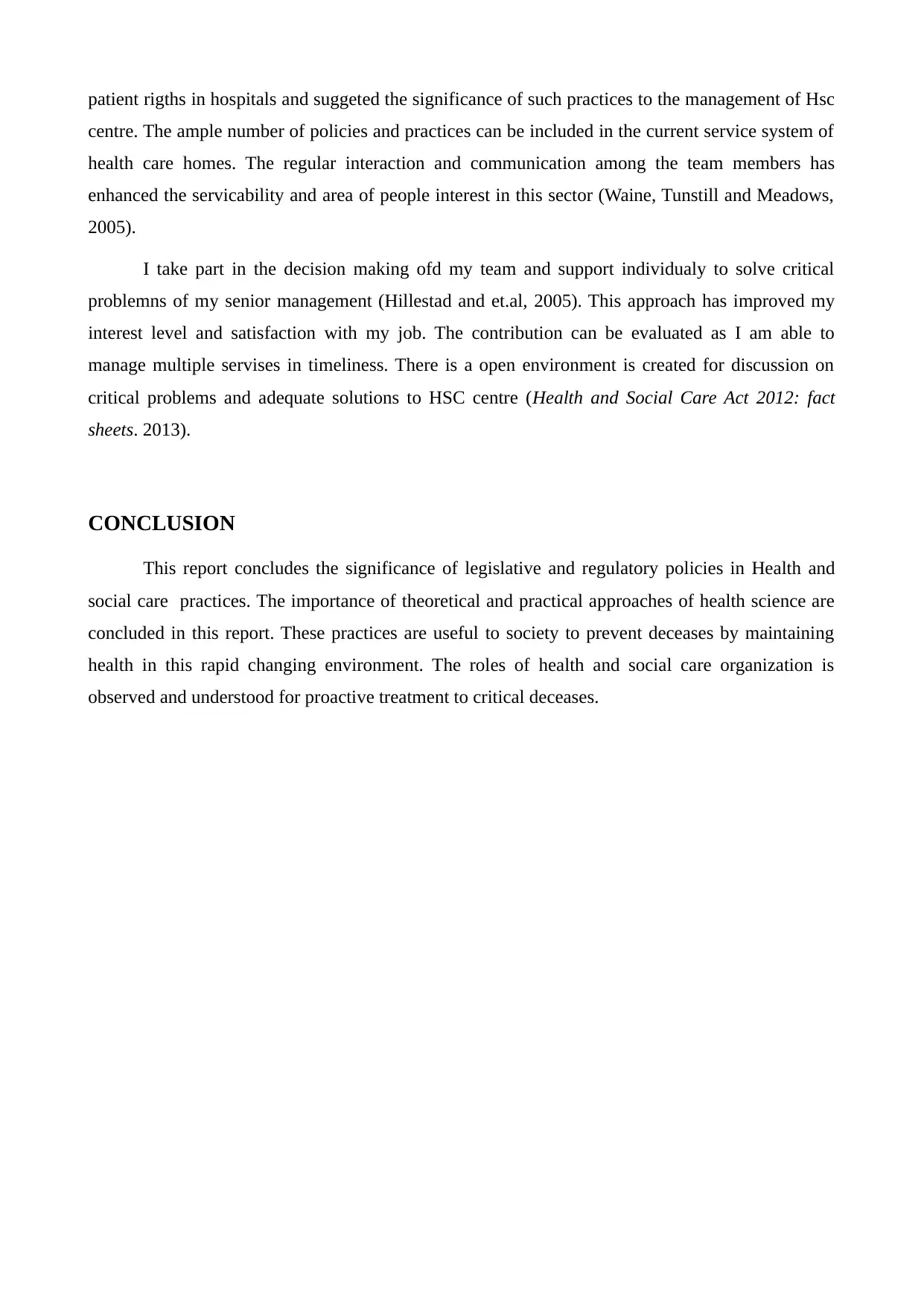
patient rigths in hospitals and suggeted the significance of such practices to the management of Hsc
centre. The ample number of policies and practices can be included in the current service system of
health care homes. The regular interaction and communication among the team members has
enhanced the servicability and area of people interest in this sector (Waine, Tunstill and Meadows,
2005).
I take part in the decision making ofd my team and support individualy to solve critical
problemns of my senior management (Hillestad and et.al, 2005). This approach has improved my
interest level and satisfaction with my job. The contribution can be evaluated as I am able to
manage multiple servises in timeliness. There is a open environment is created for discussion on
critical problems and adequate solutions to HSC centre (Health and Social Care Act 2012: fact
sheets. 2013).
CONCLUSION
This report concludes the significance of legislative and regulatory policies in Health and
social care practices. The importance of theoretical and practical approaches of health science are
concluded in this report. These practices are useful to society to prevent deceases by maintaining
health in this rapid changing environment. The roles of health and social care organization is
observed and understood for proactive treatment to critical deceases.
centre. The ample number of policies and practices can be included in the current service system of
health care homes. The regular interaction and communication among the team members has
enhanced the servicability and area of people interest in this sector (Waine, Tunstill and Meadows,
2005).
I take part in the decision making ofd my team and support individualy to solve critical
problemns of my senior management (Hillestad and et.al, 2005). This approach has improved my
interest level and satisfaction with my job. The contribution can be evaluated as I am able to
manage multiple servises in timeliness. There is a open environment is created for discussion on
critical problems and adequate solutions to HSC centre (Health and Social Care Act 2012: fact
sheets. 2013).
CONCLUSION
This report concludes the significance of legislative and regulatory policies in Health and
social care practices. The importance of theoretical and practical approaches of health science are
concluded in this report. These practices are useful to society to prevent deceases by maintaining
health in this rapid changing environment. The roles of health and social care organization is
observed and understood for proactive treatment to critical deceases.
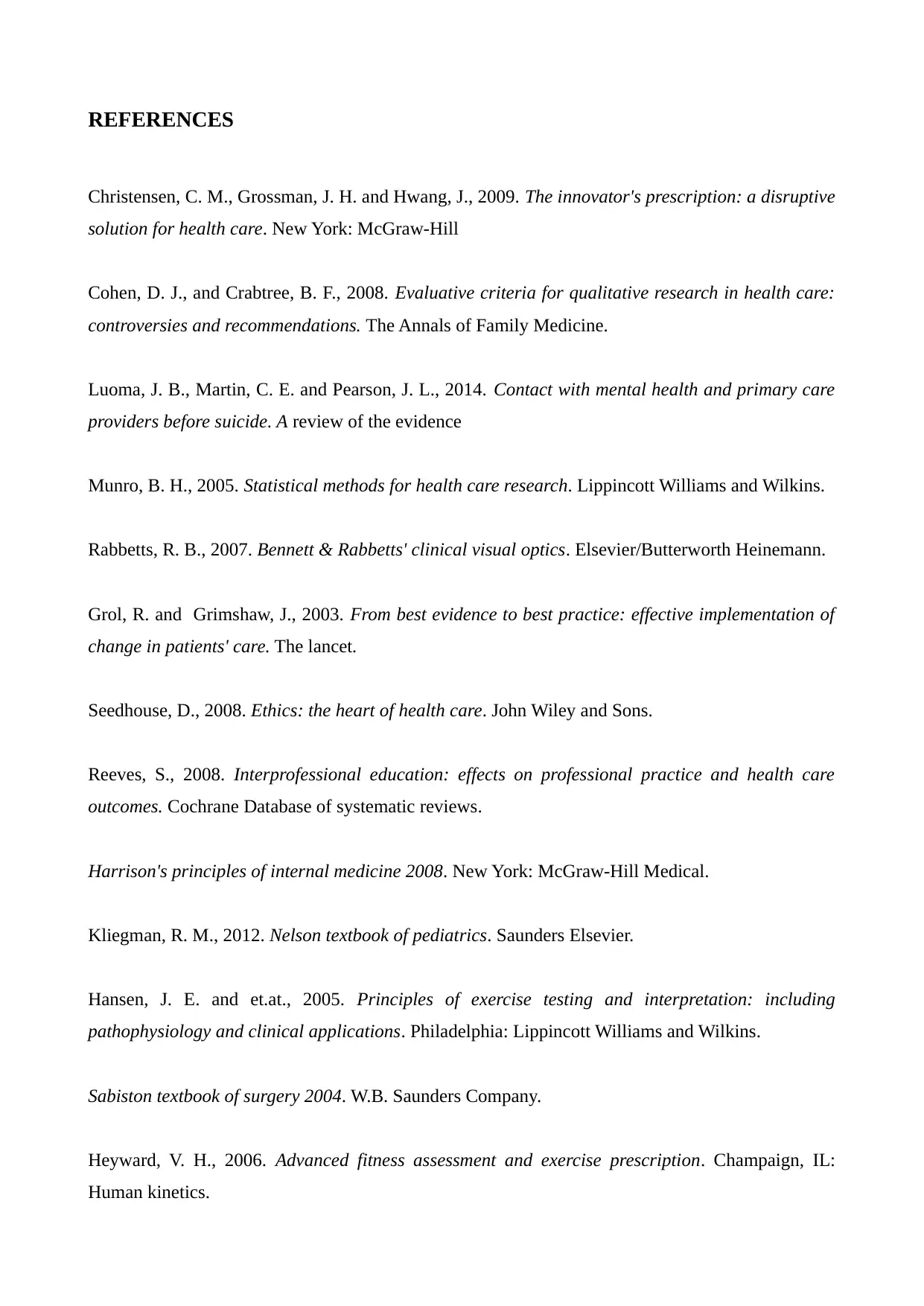
REFERENCES
Christensen, C. M., Grossman, J. H. and Hwang, J., 2009. The innovator's prescription: a disruptive
solution for health care. New York: McGraw-Hill
Cohen, D. J., and Crabtree, B. F., 2008. Evaluative criteria for qualitative research in health care:
controversies and recommendations. The Annals of Family Medicine.
Luoma, J. B., Martin, C. E. and Pearson, J. L., 2014. Contact with mental health and primary care
providers before suicide. A review of the evidence
Munro, B. H., 2005. Statistical methods for health care research. Lippincott Williams and Wilkins.
Rabbetts, R. B., 2007. Bennett & Rabbetts' clinical visual optics. Elsevier/Butterworth Heinemann.
Grol, R. and Grimshaw, J., 2003. From best evidence to best practice: effective implementation of
change in patients' care. The lancet.
Seedhouse, D., 2008. Ethics: the heart of health care. John Wiley and Sons.
Reeves, S., 2008. Interprofessional education: effects on professional practice and health care
outcomes. Cochrane Database of systematic reviews.
Harrison's principles of internal medicine 2008. New York: McGraw-Hill Medical.
Kliegman, R. M., 2012. Nelson textbook of pediatrics. Saunders Elsevier.
Hansen, J. E. and et.at., 2005. Principles of exercise testing and interpretation: including
pathophysiology and clinical applications. Philadelphia: Lippincott Williams and Wilkins.
Sabiston textbook of surgery 2004. W.B. Saunders Company.
Heyward, V. H., 2006. Advanced fitness assessment and exercise prescription. Champaign, IL:
Human kinetics.
Christensen, C. M., Grossman, J. H. and Hwang, J., 2009. The innovator's prescription: a disruptive
solution for health care. New York: McGraw-Hill
Cohen, D. J., and Crabtree, B. F., 2008. Evaluative criteria for qualitative research in health care:
controversies and recommendations. The Annals of Family Medicine.
Luoma, J. B., Martin, C. E. and Pearson, J. L., 2014. Contact with mental health and primary care
providers before suicide. A review of the evidence
Munro, B. H., 2005. Statistical methods for health care research. Lippincott Williams and Wilkins.
Rabbetts, R. B., 2007. Bennett & Rabbetts' clinical visual optics. Elsevier/Butterworth Heinemann.
Grol, R. and Grimshaw, J., 2003. From best evidence to best practice: effective implementation of
change in patients' care. The lancet.
Seedhouse, D., 2008. Ethics: the heart of health care. John Wiley and Sons.
Reeves, S., 2008. Interprofessional education: effects on professional practice and health care
outcomes. Cochrane Database of systematic reviews.
Harrison's principles of internal medicine 2008. New York: McGraw-Hill Medical.
Kliegman, R. M., 2012. Nelson textbook of pediatrics. Saunders Elsevier.
Hansen, J. E. and et.at., 2005. Principles of exercise testing and interpretation: including
pathophysiology and clinical applications. Philadelphia: Lippincott Williams and Wilkins.
Sabiston textbook of surgery 2004. W.B. Saunders Company.
Heyward, V. H., 2006. Advanced fitness assessment and exercise prescription. Champaign, IL:
Human kinetics.
⊘ This is a preview!⊘
Do you want full access?
Subscribe today to unlock all pages.

Trusted by 1+ million students worldwide
1 out of 15
Related Documents
Your All-in-One AI-Powered Toolkit for Academic Success.
+13062052269
info@desklib.com
Available 24*7 on WhatsApp / Email
![[object Object]](/_next/static/media/star-bottom.7253800d.svg)
Unlock your academic potential
Copyright © 2020–2025 A2Z Services. All Rights Reserved. Developed and managed by ZUCOL.





